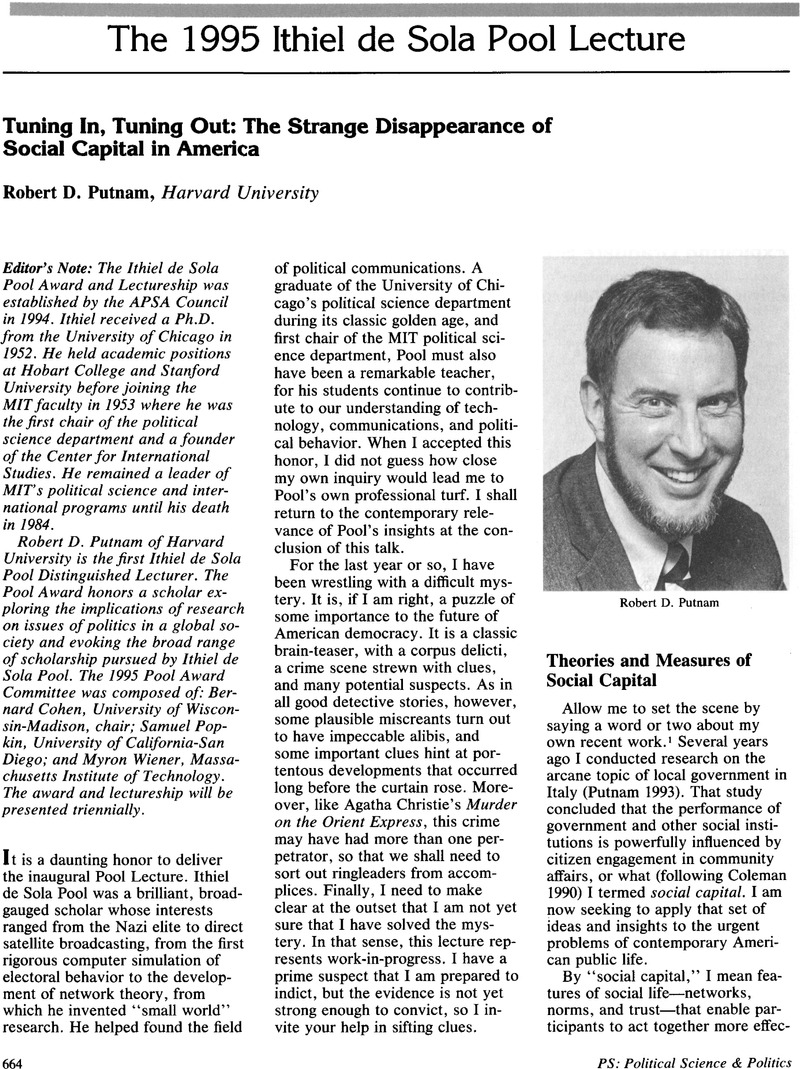Crossref Citations
This article has been cited by the following publications. This list is generated based on data provided by Crossref.
Norris, Pippa
1996.
Does Television Erode Social Capital? A Reply to Putnam.
PS: Political Science & Politics,
Vol. 29,
Issue. 3,
p.
474.
Frey, Bruno S.
1996.
A directly democratic and Federal Europe.
Constitutional Political Economy,
Vol. 7,
Issue. 4,
p.
267.
Jacobs, Lawrence R.
and
Shapiro, Robert Y.
1996.
Toward the Integrated Study of Political Communications, Public Opinion, and the Policy-making Process.
PS: Political Science & Politics,
Vol. 29,
Issue. 1,
p.
10.
Caldwell, Lynton K.
1996.
The State As a Work of Art: Statecraft for the 21st Century.
PS: Political Science & Politics,
Vol. 29,
Issue. 4,
p.
657.
Dreier, Peter
1997.
Philanthropy and the housing crisis: The dilemmas of private charity and public policy.
Housing Policy Debate,
Vol. 8,
Issue. 1,
p.
235.
Tempest, Clive
1997.
Myths from Eastern Europe and the legend of the west.
Democratization,
Vol. 4,
Issue. 1,
p.
132.
Dreier, Peter
1997.
The New Politics of Housing: How to Rebuild the Constituency for a Progressive Federal Housing Policy.
Journal of the American Planning Association,
Vol. 63,
Issue. 1,
p.
5.
Riddell, Sheila
Baron, Stephen
Stalker, Kirsten
and
Wilkinson, Heather
1997.
The concept of the learning society for adults with learning difficulties: human and social capital perspectives.
Journal of Education Policy,
Vol. 12,
Issue. 6,
p.
473.
Knack, S.
and
Keefer, P.
1997.
Does Social Capital Have an Economic Payoff? A Cross-Country Investigation.
The Quarterly Journal of Economics,
Vol. 112,
Issue. 4,
p.
1251.
Schuller, Tom
and
Field, John
1998.
Social capital, human capital and the learning society.
International Journal of Lifelong Education,
Vol. 17,
Issue. 4,
p.
226.
Useem, Bert
1998.
Breakdown Theories of Collective Action.
Annual Review of Sociology,
Vol. 24,
Issue. 1,
p.
215.
Jackman, Robert W.
and
Miller, Ross A.
1998.
SOCIAL CAPITAL AND POLITICS.
Annual Review of Political Science,
Vol. 1,
Issue. 1,
p.
47.
McDonough, Peter
Shin, Doh C.
and
Moisés, José Álvaro
1998.
Democratization and Participation: Comparing Spain, Brazil, and Korea.
The Journal of Politics,
Vol. 60,
Issue. 4,
p.
919.
Paraskevopoulos, Christos J.
1998.
Social capital and the public‐private divide in Greek regions.
West European Politics,
Vol. 21,
Issue. 2,
p.
154.
Poarch, Maria T.
1998.
Ties that bind: US suburban residents on the social and civic dimensions of work.
Community, Work & Family,
Vol. 1,
Issue. 2,
p.
125.
Shapiro, Robert Y.
1998.
Public opinion, elites, and democracy.
Critical Review,
Vol. 12,
Issue. 4,
p.
501.
Forndran, Erhard
1998.
Zwischen Triumph und Krise.
p.
303.
Jervis, Robert
1999.
Realism, Neoliberalism, and Cooperation: Understanding the Debate.
International Security,
Vol. 24,
Issue. 1,
p.
42.
Lagarde, François
Berger, Ida E.
Cunningham, Peggy H.
and
Drumwright, Minette E.
1999.
Social Alliances: Company/Nonprofit Collaboration.
Social Marketing Quarterly,
Vol. 5,
Issue. 3,
p.
48.
La Ferrara, Eliana
and
Alesina, Alberto F.
1999.
Participation in Heterogeneous Communities.
SSRN Electronic Journal,



